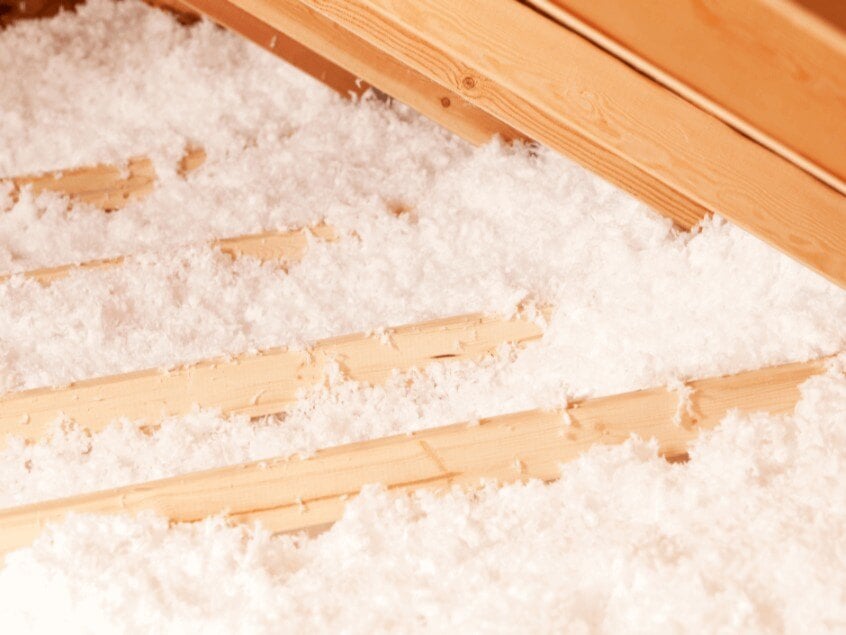Search for topics or resources
Enter your search below and hit enter or click the search icon.

You're considering blown-in insulation for your attic, but you want to know more about it before you commit. What exactly is blown-in insulation made of? Is it safe to touch? Are there any harmful chemicals in the insulation? Is one type of blown-in insulation safer than another?
South Central Services has insulated hundreds of new and existing homes around Harrisburg, PA. While we primarily install spray foam insulation, we also insulate attics with blown-in for customers with tighter budget constraints. We understand that no matter what insulation you choose, you want to be informed about what is being installed in your home.
By the end of this article, you will understand:
Don't have time to read right now? Check out everything you need to know at a glance.
Blown-in insulation is a term used to cover multiple types of insulation. When you research a general term like blown-in, the results could be for any number of insulations. Some newer blown-in products include blown-in rockwool and timber fiber.
However, blown-in fiberglass and blown-in cellulose are the two most common types. Some resources may not distinguish between these insulations or may split the difference when explaining their features.
Blown-in fiberglass and blown-in cellulose are both types of blown-in, but they have different materials and properties. Let's explore each of these insulations in more detail.
Fiberglass insulation is almost wholly comprised of plastic and glass. The insulation contents are in the name. Fine glass fibers make up the majority of fiberglass insulation, whether in blown-in, blanket, or batt form.

Fiberglass may also include some chemical additives, such as borates or boric acid. However, these chemical additives are usually less than 2% of the insulation materials. These chemicals are generally used as flame-retardants, and they help with sound control and R-value.
Depending on where you're shopping, you may see promotional materials where installers touch fiberglass insulation with bare hands. Some insulation installers do install fiberglass without wearing gloves. However, we do not recommend touching fiberglass insulation with bare hands.

Because blown-in fiberglass is composed of tiny glass fibers, there is a high likelihood of these fibers becoming embedded in your skin.
This doesn't necessarily make fiberglass insulation dangerous for your home. If you wear gloves when interacting with the insulation, you should be able to avoid contact dermatitis. It's better to be safe than itchy.
You should also wear a mask to protect your lungs.
Blown-in cellulose used to be made of recycled materials like magazines and newspapers. As digital media have overshadowed print media, fewer recyclable materials were available. Some cellulose manufacturers offer information on the quantity of recycled materials in their insulation.
As a general rule, cellulose insulation is composed of between 70% and 85% recycled paper. The remaining material may not be recycled but is still some form of cellulose. Our team installs the Nu-Wool brand of cellulose, which offers 86% recycled material. Each manufacturer may also choose different additives. Some cellulose products are strictly protected with borate, while others may use multiple chemicals.
No matter what chemicals are used, these insulations undergo strict testing to ensure they are safe for the home. You can check out safety data sheets for any insulation product for more detailed information.
Unlike blown-in fiberglass, blown-in cellulose is safe to touch with bare hands. While your hands may come away dusty, contact dermatitis is not a risk when touching ground-up paper.

Blown-in insulation is a catch-all term that refers to both cellulose and fiberglass. Both are used as blown-in products but are made of different materials. Blown-in fiberglass is mainly composed of fine glass and plastic fibers with a few chemical additives. Blown-in cellulose is made of cellulose materials like recycled paper.
The exact formulas, additives, and percentage of recycled materials vary by brand. However, all brands of blown-in insulation must complete testing to ensure they are safe for the home. While neither fiberglass nor cellulose materials will put your family in danger, it is wise to interact with these insulations while wearing personal protective equipment (PPE).
Now that you understand what blown-in insulations are made of, your next step is to:
Disclaimer: While we strive to publish information accurate to building science, local building codes and standards supersede our recommendations.
Kilian has co-owned and operated South Central Services for 8 years. He is passionate about community involvement. In his spare time, he enjoys being with his family, playing ice hockey, and going fishing with friends.
Topics: